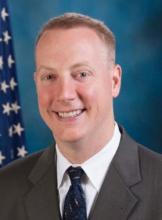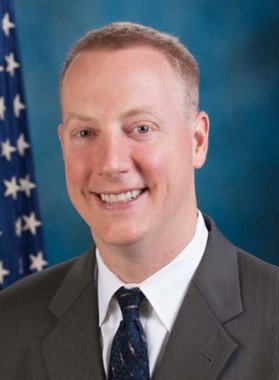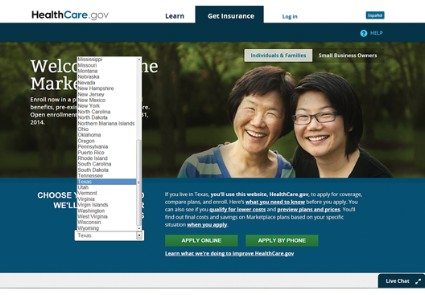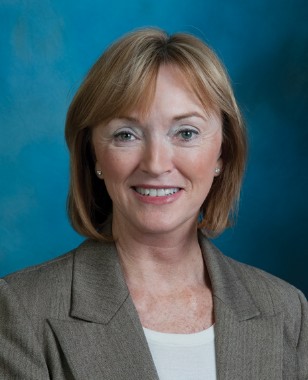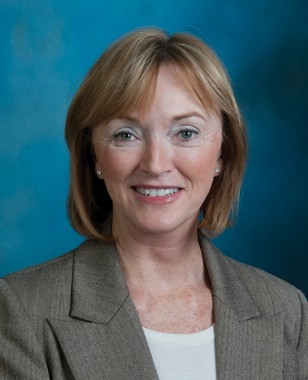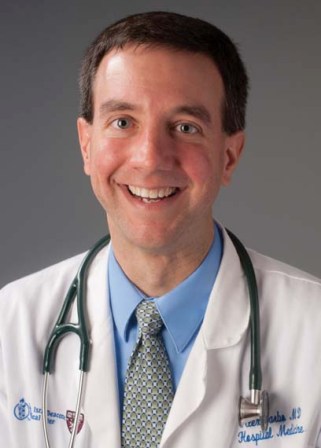User login
Burwell gets a step closer to HHS helm
Sylvia Mathews Burwell, the nominee to become the next secretary of the Department of Health & Human Services, got a warm reception from senators in her first confirmation hearing.
Ms. Burwell, who is the current director of the Office of Management and Budget, was widely praised for her competence, compassion, and willingness to work with lawmakers of both parties. She was endorsed by Sen. John McCain (R-Ariz.), who favors replacing the Affordable Care Act. He said that regardless of how senators feel about the health law, they should confirm Ms. Burwell, because she is well qualified to lead HHS and will be more responsive than the current secretary, Kathleen Sebelius.
Sen. McCain added that he tried to discourage her from accepting the "thankless" job. "Who would recommend their friend take over as captain of the Titanic after it hit the iceberg?" he said.
During the 2-hour hearing, lawmakers on the Senate Committee on Health, Education, Labor & Pensions took advantage of their first chance to question Ms. Burwell, querying her on a range of issues from the shortage of primary care providers to the speed of drug approvals at the Food and Drug Administration.
When asked about her approach to employing the controversial Independent Payment Advisory Board, Ms. Burwell said she hopes that it will never be triggered, because the government will keep health care costs under control.
And when it comes to the past failures of HHS in managing the healthcare.gov rollout, Ms. Burwell said she learned that there needs to be a different approach to handling information technology procurement and delivery. She pledged to ensure there was "ownership and accountability" in the IT operations in the future.
She also promised GOP senators that she would share information with them. "I am here to serve the American people," she said.
Ms. Burwell is not expected to have a tough confirmation battle. New Senate rules allow her to be confirmed with only a majority vote, and she received a unanimous confirmation vote for her current post last April. She will face questioning next from the Senate Finance Committee.
Ms. Burwell, a Rhodes Scholar from Hinton, W.Va., previously served as president of the Walmart Foundation and as president of the global development program at the Bill & Melinda Gates Foundation. During the Clinton administration, she worked as deputy director of the Office of Management and Budget.
On Twitter @maryellenny
Sylvia Mathews Burwell, the nominee to become the next secretary of the Department of Health & Human Services, got a warm reception from senators in her first confirmation hearing.
Ms. Burwell, who is the current director of the Office of Management and Budget, was widely praised for her competence, compassion, and willingness to work with lawmakers of both parties. She was endorsed by Sen. John McCain (R-Ariz.), who favors replacing the Affordable Care Act. He said that regardless of how senators feel about the health law, they should confirm Ms. Burwell, because she is well qualified to lead HHS and will be more responsive than the current secretary, Kathleen Sebelius.
Sen. McCain added that he tried to discourage her from accepting the "thankless" job. "Who would recommend their friend take over as captain of the Titanic after it hit the iceberg?" he said.
During the 2-hour hearing, lawmakers on the Senate Committee on Health, Education, Labor & Pensions took advantage of their first chance to question Ms. Burwell, querying her on a range of issues from the shortage of primary care providers to the speed of drug approvals at the Food and Drug Administration.
When asked about her approach to employing the controversial Independent Payment Advisory Board, Ms. Burwell said she hopes that it will never be triggered, because the government will keep health care costs under control.
And when it comes to the past failures of HHS in managing the healthcare.gov rollout, Ms. Burwell said she learned that there needs to be a different approach to handling information technology procurement and delivery. She pledged to ensure there was "ownership and accountability" in the IT operations in the future.
She also promised GOP senators that she would share information with them. "I am here to serve the American people," she said.
Ms. Burwell is not expected to have a tough confirmation battle. New Senate rules allow her to be confirmed with only a majority vote, and she received a unanimous confirmation vote for her current post last April. She will face questioning next from the Senate Finance Committee.
Ms. Burwell, a Rhodes Scholar from Hinton, W.Va., previously served as president of the Walmart Foundation and as president of the global development program at the Bill & Melinda Gates Foundation. During the Clinton administration, she worked as deputy director of the Office of Management and Budget.
On Twitter @maryellenny
Sylvia Mathews Burwell, the nominee to become the next secretary of the Department of Health & Human Services, got a warm reception from senators in her first confirmation hearing.
Ms. Burwell, who is the current director of the Office of Management and Budget, was widely praised for her competence, compassion, and willingness to work with lawmakers of both parties. She was endorsed by Sen. John McCain (R-Ariz.), who favors replacing the Affordable Care Act. He said that regardless of how senators feel about the health law, they should confirm Ms. Burwell, because she is well qualified to lead HHS and will be more responsive than the current secretary, Kathleen Sebelius.
Sen. McCain added that he tried to discourage her from accepting the "thankless" job. "Who would recommend their friend take over as captain of the Titanic after it hit the iceberg?" he said.
During the 2-hour hearing, lawmakers on the Senate Committee on Health, Education, Labor & Pensions took advantage of their first chance to question Ms. Burwell, querying her on a range of issues from the shortage of primary care providers to the speed of drug approvals at the Food and Drug Administration.
When asked about her approach to employing the controversial Independent Payment Advisory Board, Ms. Burwell said she hopes that it will never be triggered, because the government will keep health care costs under control.
And when it comes to the past failures of HHS in managing the healthcare.gov rollout, Ms. Burwell said she learned that there needs to be a different approach to handling information technology procurement and delivery. She pledged to ensure there was "ownership and accountability" in the IT operations in the future.
She also promised GOP senators that she would share information with them. "I am here to serve the American people," she said.
Ms. Burwell is not expected to have a tough confirmation battle. New Senate rules allow her to be confirmed with only a majority vote, and she received a unanimous confirmation vote for her current post last April. She will face questioning next from the Senate Finance Committee.
Ms. Burwell, a Rhodes Scholar from Hinton, W.Va., previously served as president of the Walmart Foundation and as president of the global development program at the Bill & Melinda Gates Foundation. During the Clinton administration, she worked as deputy director of the Office of Management and Budget.
On Twitter @maryellenny
HHS: Hospital readmissions dropping
Physicians are making a real dent in hospital readmissions, improving bounce-back rates by 8% during 2011 and 2012, according to preliminary government data.
The rate of 30-day all-cause readmissions in the Medicare fee for service program was 17.5% in 2013, down from 18.5% in 2012. National rates had been stuck around 19.5% during the 5 previous years.
The preliminary data, which were released on May 7, were compiled by the Agency for Healthcare Research and Quality.
Federal officials credited the Affordable Care Act with providing the tools hospitals needed to make the improvements, including one provision that ties hospital payments to reductions in readmission rates. The Medicare Readmissions Reduction Program, which launched in 2012, imposes payment penalties on hospitals with high readmission rates. Starting in October, the penalty will rise to 3% and will be based on readmissions for acute myocardial infarction, heart failure, pneumonia, chronic obstructive pulmonary disease, and hip/knee arthroplasty.
Injuries and deaths from adverse drug events, falls, and infections are also declining, according to the new data. Nationally, hospital-acquired conditions decreased 9% between 2010 and 2012. The safety gains translated into nearly 15,000 fewer deaths in hospitals and $3.2 billion in decreased costs to the health care system in 2012 alone, according to HHS.
Dr. Patrick Conway, the chief medical officer and director of the Center for Clinical Standards and Quality at the Centers for Medicare & Medicaid Services, gave a preview of the data in March at the annual meeting of the Society of Hospital Medicine. He credited hospitalists for their role in achieving the "dramatic progress."
"You are improving so fast on quality process of care measures for CMS that we actually have to pull them out of the program," Dr. Conway told the audience of hospitalists. "We’ve removed almost half of the measures that were in hospital value-based purchasing in the inpatient quality reporting program over the last 3 years and that’s because the performance has increased so much."
On Twitter @maryellenny
Physicians are making a real dent in hospital readmissions, improving bounce-back rates by 8% during 2011 and 2012, according to preliminary government data.
The rate of 30-day all-cause readmissions in the Medicare fee for service program was 17.5% in 2013, down from 18.5% in 2012. National rates had been stuck around 19.5% during the 5 previous years.
The preliminary data, which were released on May 7, were compiled by the Agency for Healthcare Research and Quality.
Federal officials credited the Affordable Care Act with providing the tools hospitals needed to make the improvements, including one provision that ties hospital payments to reductions in readmission rates. The Medicare Readmissions Reduction Program, which launched in 2012, imposes payment penalties on hospitals with high readmission rates. Starting in October, the penalty will rise to 3% and will be based on readmissions for acute myocardial infarction, heart failure, pneumonia, chronic obstructive pulmonary disease, and hip/knee arthroplasty.
Injuries and deaths from adverse drug events, falls, and infections are also declining, according to the new data. Nationally, hospital-acquired conditions decreased 9% between 2010 and 2012. The safety gains translated into nearly 15,000 fewer deaths in hospitals and $3.2 billion in decreased costs to the health care system in 2012 alone, according to HHS.
Dr. Patrick Conway, the chief medical officer and director of the Center for Clinical Standards and Quality at the Centers for Medicare & Medicaid Services, gave a preview of the data in March at the annual meeting of the Society of Hospital Medicine. He credited hospitalists for their role in achieving the "dramatic progress."
"You are improving so fast on quality process of care measures for CMS that we actually have to pull them out of the program," Dr. Conway told the audience of hospitalists. "We’ve removed almost half of the measures that were in hospital value-based purchasing in the inpatient quality reporting program over the last 3 years and that’s because the performance has increased so much."
On Twitter @maryellenny
Physicians are making a real dent in hospital readmissions, improving bounce-back rates by 8% during 2011 and 2012, according to preliminary government data.
The rate of 30-day all-cause readmissions in the Medicare fee for service program was 17.5% in 2013, down from 18.5% in 2012. National rates had been stuck around 19.5% during the 5 previous years.
The preliminary data, which were released on May 7, were compiled by the Agency for Healthcare Research and Quality.
Federal officials credited the Affordable Care Act with providing the tools hospitals needed to make the improvements, including one provision that ties hospital payments to reductions in readmission rates. The Medicare Readmissions Reduction Program, which launched in 2012, imposes payment penalties on hospitals with high readmission rates. Starting in October, the penalty will rise to 3% and will be based on readmissions for acute myocardial infarction, heart failure, pneumonia, chronic obstructive pulmonary disease, and hip/knee arthroplasty.
Injuries and deaths from adverse drug events, falls, and infections are also declining, according to the new data. Nationally, hospital-acquired conditions decreased 9% between 2010 and 2012. The safety gains translated into nearly 15,000 fewer deaths in hospitals and $3.2 billion in decreased costs to the health care system in 2012 alone, according to HHS.
Dr. Patrick Conway, the chief medical officer and director of the Center for Clinical Standards and Quality at the Centers for Medicare & Medicaid Services, gave a preview of the data in March at the annual meeting of the Society of Hospital Medicine. He credited hospitalists for their role in achieving the "dramatic progress."
"You are improving so fast on quality process of care measures for CMS that we actually have to pull them out of the program," Dr. Conway told the audience of hospitalists. "We’ve removed almost half of the measures that were in hospital value-based purchasing in the inpatient quality reporting program over the last 3 years and that’s because the performance has increased so much."
On Twitter @maryellenny
New ICD-10 deadline: Oct. 1, 2015
The new deadline for making the switch to the ICD-10 coding system is Oct. 1, 2015, the Centers for Medicare & Medicaid Services announced.
On April 1, President Obama signed legislation that delayed the start of ICD-10 from Oct. 1, 2014, until at least a year later. The law did not specify a new start date, leaving the physicians and health care providers wondering how long they would have to prepare for the new code set.
CMS officials said they will release an interim final rule in the "near future" with more details about the compliance date. But the rule will require physicians to continue to use ICD-9 through Sept. 30, 2015.
On Twitter @maryellenny
The new deadline for making the switch to the ICD-10 coding system is Oct. 1, 2015, the Centers for Medicare & Medicaid Services announced.
On April 1, President Obama signed legislation that delayed the start of ICD-10 from Oct. 1, 2014, until at least a year later. The law did not specify a new start date, leaving the physicians and health care providers wondering how long they would have to prepare for the new code set.
CMS officials said they will release an interim final rule in the "near future" with more details about the compliance date. But the rule will require physicians to continue to use ICD-9 through Sept. 30, 2015.
On Twitter @maryellenny
The new deadline for making the switch to the ICD-10 coding system is Oct. 1, 2015, the Centers for Medicare & Medicaid Services announced.
On April 1, President Obama signed legislation that delayed the start of ICD-10 from Oct. 1, 2014, until at least a year later. The law did not specify a new start date, leaving the physicians and health care providers wondering how long they would have to prepare for the new code set.
CMS officials said they will release an interim final rule in the "near future" with more details about the compliance date. But the rule will require physicians to continue to use ICD-9 through Sept. 30, 2015.
On Twitter @maryellenny
Physician education key to curbing opioid abuse
Despite startling statistics on the abuse of prescription opioids and the rising number of overdose deaths, physicians still don’t get enough training on how to properly prescribe these drugs, according to federal health officials.
Ramping up education of prescribers is one of the federal government’s main strategies for combating opioid addiction, health officials told lawmakers during a hearing of the House Energy and Commerce Committee on April 29. Lawmakers convened the hearing to discuss concerns about continued prescription opioid abuse and reports that some people are transitioning from prescription opioids to heroin.
About 100 Americans died from a drug overdose each day in 2010, according to the Centers for Disease Control and Prevention. Overall, there were more than 38,300 overdose deaths in 2010, with prescription opioids involved in more than 16,600 and heroin involved in about 3,000. Deaths from drug overdose in the United States now eclipse those from gunshot wounds and car crashes, according to the CDC.
Along with prescriber education, federal agencies are also expanding state-based prescription drug monitoring programs, providing more ways for people to safely dispose of unused prescription drugs, and shutting down pill mills and discouraging doctor shopping, said Michael Botticelli, acting director of the Office of National Drug Control Policy.
Federal agencies also are expanding access to substance abuse treatment and trying to get the word out about emergency overdose reversal medications like naloxone (Narcan).
"It is clear we cannot arrest our way out of the drug problem," Mr. Botticelli said.
One problem is that physicians are both undertreating chronic pain and overprescribing opioids, said Dr. Nora D. Volkow, director of the National Institute on Drug Abuse. There’s room for improvement when it comes to educating prescribers, she said. For instance, education efforts need to include not only which types of patients are appropriate for opioids, but how many pills they should get.
Several states, including Iowa, Kentucky, Massachusetts, Ohio, Tennessee, and Utah, have passed legislation mandating prescriber education. Mr. Botticelli said his agency is encouraging other states to do the same.
One tool that can be used by physicians, patients, and first responders is a free opioid overdose prevention toolkit from the Substance Abuse and Mental Health Services Administration (SAMHSA). The toolkit, originally released last year, takes physicians step by step through evaluating new patients, selecting an appropriate therapy, executing the prescription order, monitoring the patient’s response to treatment, and deciding when to end opioid therapy. It also provides tips on when to prescribe naloxone – an opioid antagonist– with the initial opioid prescription.
For instance, SAMHSA cautions physicians to take special care in evaluating new patients. In addition to a standard history and examination, SAMHSA officials recommend finding out who last treated the patient, what medications were previously prescribed, and what substances (including alcohol) that patient has used.
Even if an opioid analgesic is appropriate, the amount still should be limited. Physicians should prescribe only enough to meet the patient’s needs until the next appointment.
On Twitter @maryellenny
Despite startling statistics on the abuse of prescription opioids and the rising number of overdose deaths, physicians still don’t get enough training on how to properly prescribe these drugs, according to federal health officials.
Ramping up education of prescribers is one of the federal government’s main strategies for combating opioid addiction, health officials told lawmakers during a hearing of the House Energy and Commerce Committee on April 29. Lawmakers convened the hearing to discuss concerns about continued prescription opioid abuse and reports that some people are transitioning from prescription opioids to heroin.
About 100 Americans died from a drug overdose each day in 2010, according to the Centers for Disease Control and Prevention. Overall, there were more than 38,300 overdose deaths in 2010, with prescription opioids involved in more than 16,600 and heroin involved in about 3,000. Deaths from drug overdose in the United States now eclipse those from gunshot wounds and car crashes, according to the CDC.
Along with prescriber education, federal agencies are also expanding state-based prescription drug monitoring programs, providing more ways for people to safely dispose of unused prescription drugs, and shutting down pill mills and discouraging doctor shopping, said Michael Botticelli, acting director of the Office of National Drug Control Policy.
Federal agencies also are expanding access to substance abuse treatment and trying to get the word out about emergency overdose reversal medications like naloxone (Narcan).
"It is clear we cannot arrest our way out of the drug problem," Mr. Botticelli said.
One problem is that physicians are both undertreating chronic pain and overprescribing opioids, said Dr. Nora D. Volkow, director of the National Institute on Drug Abuse. There’s room for improvement when it comes to educating prescribers, she said. For instance, education efforts need to include not only which types of patients are appropriate for opioids, but how many pills they should get.
Several states, including Iowa, Kentucky, Massachusetts, Ohio, Tennessee, and Utah, have passed legislation mandating prescriber education. Mr. Botticelli said his agency is encouraging other states to do the same.
One tool that can be used by physicians, patients, and first responders is a free opioid overdose prevention toolkit from the Substance Abuse and Mental Health Services Administration (SAMHSA). The toolkit, originally released last year, takes physicians step by step through evaluating new patients, selecting an appropriate therapy, executing the prescription order, monitoring the patient’s response to treatment, and deciding when to end opioid therapy. It also provides tips on when to prescribe naloxone – an opioid antagonist– with the initial opioid prescription.
For instance, SAMHSA cautions physicians to take special care in evaluating new patients. In addition to a standard history and examination, SAMHSA officials recommend finding out who last treated the patient, what medications were previously prescribed, and what substances (including alcohol) that patient has used.
Even if an opioid analgesic is appropriate, the amount still should be limited. Physicians should prescribe only enough to meet the patient’s needs until the next appointment.
On Twitter @maryellenny
Despite startling statistics on the abuse of prescription opioids and the rising number of overdose deaths, physicians still don’t get enough training on how to properly prescribe these drugs, according to federal health officials.
Ramping up education of prescribers is one of the federal government’s main strategies for combating opioid addiction, health officials told lawmakers during a hearing of the House Energy and Commerce Committee on April 29. Lawmakers convened the hearing to discuss concerns about continued prescription opioid abuse and reports that some people are transitioning from prescription opioids to heroin.
About 100 Americans died from a drug overdose each day in 2010, according to the Centers for Disease Control and Prevention. Overall, there were more than 38,300 overdose deaths in 2010, with prescription opioids involved in more than 16,600 and heroin involved in about 3,000. Deaths from drug overdose in the United States now eclipse those from gunshot wounds and car crashes, according to the CDC.
Along with prescriber education, federal agencies are also expanding state-based prescription drug monitoring programs, providing more ways for people to safely dispose of unused prescription drugs, and shutting down pill mills and discouraging doctor shopping, said Michael Botticelli, acting director of the Office of National Drug Control Policy.
Federal agencies also are expanding access to substance abuse treatment and trying to get the word out about emergency overdose reversal medications like naloxone (Narcan).
"It is clear we cannot arrest our way out of the drug problem," Mr. Botticelli said.
One problem is that physicians are both undertreating chronic pain and overprescribing opioids, said Dr. Nora D. Volkow, director of the National Institute on Drug Abuse. There’s room for improvement when it comes to educating prescribers, she said. For instance, education efforts need to include not only which types of patients are appropriate for opioids, but how many pills they should get.
Several states, including Iowa, Kentucky, Massachusetts, Ohio, Tennessee, and Utah, have passed legislation mandating prescriber education. Mr. Botticelli said his agency is encouraging other states to do the same.
One tool that can be used by physicians, patients, and first responders is a free opioid overdose prevention toolkit from the Substance Abuse and Mental Health Services Administration (SAMHSA). The toolkit, originally released last year, takes physicians step by step through evaluating new patients, selecting an appropriate therapy, executing the prescription order, monitoring the patient’s response to treatment, and deciding when to end opioid therapy. It also provides tips on when to prescribe naloxone – an opioid antagonist– with the initial opioid prescription.
For instance, SAMHSA cautions physicians to take special care in evaluating new patients. In addition to a standard history and examination, SAMHSA officials recommend finding out who last treated the patient, what medications were previously prescribed, and what substances (including alcohol) that patient has used.
Even if an opioid analgesic is appropriate, the amount still should be limited. Physicians should prescribe only enough to meet the patient’s needs until the next appointment.
On Twitter @maryellenny
Eight million enroll in ACA plans; 28% are young adults
With the official figures in, the federal government reported that more than 8 million Americans enrolled in private health plans through either state- or federally run insurance marketplaces between Oct. 1 and April 19.
A month after the close of the Affordable Care Act’s first open enrollment period, the Health & Human Services department released a detailed accounting of enrollment through the marketplaces. The final number for private plans was 8,019,763, including individuals who enrolled during the special enrollment extension ending April 19.
HHS officials still could not say how many of the individuals who signed up for coverage had paid their premiums. That information won’t be available until later this year, they said.
It’s also still unclear how many of those who signed up for health plans through the marketplaces gained coverage for the first time. Among the 5.18 million individuals who selected plans in the federal marketplaces and also applied for financial assistance, only 13% said they had coverage at the time of their application. But HHS officials said that number is probably not reliable because it only includes a subset of enrollees and they were asked a narrow question about coverage, which did not take into account whether individuals had recently lost their coverage.
According to federal officials, an additional 4.8 million people gained insurance coverage via Medicaid and the Children’s Health Insurance Program, an additional 3 million adults under age 26 gained coverage by staying on their parents’ health plans, and an estimated 5 million people gained coverage by buying ACA-compliant plans outside of the marketplaces.
The report also sheds some light on who the newly insured are.
The majority of those who signed up for coverage on the ACA marketplaces were women (54%). About a third were under age 35, with 28% between the ages of 18 and 34 years. The largest number of sign-ups were among individuals aged 45-54 years (23%) and 55-64 years (25%).
Most who signed up (85%) qualified for financial assistance. The most popular type of health plan was the "silver" plan, with 65% selecting that plan and another 20% opting for the "bronze" plans.
Race/ethnicity was reported by 69% of enrollees. Of those, nearly 63% reported their race/ethnicity as white, 17% were African American, 11% were Latino, 8% were Asian, 1% were multiracial, and less than 1% were American Indian/Alaska Native and Native Hawaiian/Pacific Islander.
Republican lawmakers on the House Energy and Commerce Committee contend that only 67% of those who have selected a health plan in the federal marketplaces had paid their first month’s premium as of April 15. The committee said their information came from asking the insurance companies participating in the marketplaces for their enrollment data.
On Twitter @maryellenny
With the official figures in, the federal government reported that more than 8 million Americans enrolled in private health plans through either state- or federally run insurance marketplaces between Oct. 1 and April 19.
A month after the close of the Affordable Care Act’s first open enrollment period, the Health & Human Services department released a detailed accounting of enrollment through the marketplaces. The final number for private plans was 8,019,763, including individuals who enrolled during the special enrollment extension ending April 19.
HHS officials still could not say how many of the individuals who signed up for coverage had paid their premiums. That information won’t be available until later this year, they said.
It’s also still unclear how many of those who signed up for health plans through the marketplaces gained coverage for the first time. Among the 5.18 million individuals who selected plans in the federal marketplaces and also applied for financial assistance, only 13% said they had coverage at the time of their application. But HHS officials said that number is probably not reliable because it only includes a subset of enrollees and they were asked a narrow question about coverage, which did not take into account whether individuals had recently lost their coverage.
According to federal officials, an additional 4.8 million people gained insurance coverage via Medicaid and the Children’s Health Insurance Program, an additional 3 million adults under age 26 gained coverage by staying on their parents’ health plans, and an estimated 5 million people gained coverage by buying ACA-compliant plans outside of the marketplaces.
The report also sheds some light on who the newly insured are.
The majority of those who signed up for coverage on the ACA marketplaces were women (54%). About a third were under age 35, with 28% between the ages of 18 and 34 years. The largest number of sign-ups were among individuals aged 45-54 years (23%) and 55-64 years (25%).
Most who signed up (85%) qualified for financial assistance. The most popular type of health plan was the "silver" plan, with 65% selecting that plan and another 20% opting for the "bronze" plans.
Race/ethnicity was reported by 69% of enrollees. Of those, nearly 63% reported their race/ethnicity as white, 17% were African American, 11% were Latino, 8% were Asian, 1% were multiracial, and less than 1% were American Indian/Alaska Native and Native Hawaiian/Pacific Islander.
Republican lawmakers on the House Energy and Commerce Committee contend that only 67% of those who have selected a health plan in the federal marketplaces had paid their first month’s premium as of April 15. The committee said their information came from asking the insurance companies participating in the marketplaces for their enrollment data.
On Twitter @maryellenny
With the official figures in, the federal government reported that more than 8 million Americans enrolled in private health plans through either state- or federally run insurance marketplaces between Oct. 1 and April 19.
A month after the close of the Affordable Care Act’s first open enrollment period, the Health & Human Services department released a detailed accounting of enrollment through the marketplaces. The final number for private plans was 8,019,763, including individuals who enrolled during the special enrollment extension ending April 19.
HHS officials still could not say how many of the individuals who signed up for coverage had paid their premiums. That information won’t be available until later this year, they said.
It’s also still unclear how many of those who signed up for health plans through the marketplaces gained coverage for the first time. Among the 5.18 million individuals who selected plans in the federal marketplaces and also applied for financial assistance, only 13% said they had coverage at the time of their application. But HHS officials said that number is probably not reliable because it only includes a subset of enrollees and they were asked a narrow question about coverage, which did not take into account whether individuals had recently lost their coverage.
According to federal officials, an additional 4.8 million people gained insurance coverage via Medicaid and the Children’s Health Insurance Program, an additional 3 million adults under age 26 gained coverage by staying on their parents’ health plans, and an estimated 5 million people gained coverage by buying ACA-compliant plans outside of the marketplaces.
The report also sheds some light on who the newly insured are.
The majority of those who signed up for coverage on the ACA marketplaces were women (54%). About a third were under age 35, with 28% between the ages of 18 and 34 years. The largest number of sign-ups were among individuals aged 45-54 years (23%) and 55-64 years (25%).
Most who signed up (85%) qualified for financial assistance. The most popular type of health plan was the "silver" plan, with 65% selecting that plan and another 20% opting for the "bronze" plans.
Race/ethnicity was reported by 69% of enrollees. Of those, nearly 63% reported their race/ethnicity as white, 17% were African American, 11% were Latino, 8% were Asian, 1% were multiracial, and less than 1% were American Indian/Alaska Native and Native Hawaiian/Pacific Islander.
Republican lawmakers on the House Energy and Commerce Committee contend that only 67% of those who have selected a health plan in the federal marketplaces had paid their first month’s premium as of April 15. The committee said their information came from asking the insurance companies participating in the marketplaces for their enrollment data.
On Twitter @maryellenny
Medicare projects $241M drop in hospital payments
General acute care hospitals are likely to see their Medicare payments drop slightly next year because of penalties for readmissions and hospital-acquired conditions, as well as other proposed payment cuts.
The Centers for Medicare & Medicaid Services released a proposed rule with new payment policies for fiscal year 2015 under the Inpatient Prospective Payment System and the Long-Term Care Hospital Prospective Payment System April 30. The proposal would provide a 1.3% payment increase for general acute care hospitals for fiscal year 2015 and a 0.8% increase for long-term care hospitals.
But the agency estimates that general acute care hospitals will actually see a 0.8% pay cut because of reductions from the Hospital Readmissions Reduction Program, the Hospital-Acquired Condition Reduction Program, cuts to disproportionate share hospitals, and the expiration of some temporary payment increases.
Overall, the CMS estimates that Medicare spending on inpatient hospital services will drop by about $241 million in the next fiscal year, while payments to long-term care hospitals are projected to increase by $44 million.
The proposal also places new requirements on hospitals to be open with their patients about prices. Under the rule, the CMS is requiring hospitals to either make a list of their standard charges publicly available or publicize their policies for allowing the public to view a list of charges upon request.
"This proposed rule is geared toward improving hospital performance while creating an environment for improved Medicare beneficiary care and satisfaction," CMS Administrator Marilyn Tavenner said in a statement.
The proposal also increases the penalties for some quality improvement programs: For example, the CMS will reduce the base operating diagnosis-related group payment amounts for all hospitals 1.5%, up from 1.25% this year. Overall, the CMS estimates that $1.4 billion will be available to fund incentive payments through the program in the next fiscal year.
The proposal also calls for increasing penalties* for hospital readmissions from 2% to 3% starting in October. Hospitals will be evaluated based on how well they do in reducing readmissions due to myocardial infarction, heart failure, pneumonia, chronic obstructive pulmonary disease, and hip/knee arthroplasty.
The CMS is also proposing to launch the Hospital Acquired Condition Reduction Program in October. This Affordable Care Act program will reduce Medicare inpatient payments by 1% for hospitals with the poorest record of preventing hospital-acquired conditions.
The public can comment on the proposal until June 30 at regulations.gov. The CMS said a final rule will be issued by Aug. 1.
On Twitter @maryellenny
*CORRECTION, 5/2/2014: An earlier version of this story incorrectly stated that there would be increased payments for hospital readmissions
General acute care hospitals are likely to see their Medicare payments drop slightly next year because of penalties for readmissions and hospital-acquired conditions, as well as other proposed payment cuts.
The Centers for Medicare & Medicaid Services released a proposed rule with new payment policies for fiscal year 2015 under the Inpatient Prospective Payment System and the Long-Term Care Hospital Prospective Payment System April 30. The proposal would provide a 1.3% payment increase for general acute care hospitals for fiscal year 2015 and a 0.8% increase for long-term care hospitals.
But the agency estimates that general acute care hospitals will actually see a 0.8% pay cut because of reductions from the Hospital Readmissions Reduction Program, the Hospital-Acquired Condition Reduction Program, cuts to disproportionate share hospitals, and the expiration of some temporary payment increases.
Overall, the CMS estimates that Medicare spending on inpatient hospital services will drop by about $241 million in the next fiscal year, while payments to long-term care hospitals are projected to increase by $44 million.
The proposal also places new requirements on hospitals to be open with their patients about prices. Under the rule, the CMS is requiring hospitals to either make a list of their standard charges publicly available or publicize their policies for allowing the public to view a list of charges upon request.
"This proposed rule is geared toward improving hospital performance while creating an environment for improved Medicare beneficiary care and satisfaction," CMS Administrator Marilyn Tavenner said in a statement.
The proposal also increases the penalties for some quality improvement programs: For example, the CMS will reduce the base operating diagnosis-related group payment amounts for all hospitals 1.5%, up from 1.25% this year. Overall, the CMS estimates that $1.4 billion will be available to fund incentive payments through the program in the next fiscal year.
The proposal also calls for increasing penalties* for hospital readmissions from 2% to 3% starting in October. Hospitals will be evaluated based on how well they do in reducing readmissions due to myocardial infarction, heart failure, pneumonia, chronic obstructive pulmonary disease, and hip/knee arthroplasty.
The CMS is also proposing to launch the Hospital Acquired Condition Reduction Program in October. This Affordable Care Act program will reduce Medicare inpatient payments by 1% for hospitals with the poorest record of preventing hospital-acquired conditions.
The public can comment on the proposal until June 30 at regulations.gov. The CMS said a final rule will be issued by Aug. 1.
On Twitter @maryellenny
*CORRECTION, 5/2/2014: An earlier version of this story incorrectly stated that there would be increased payments for hospital readmissions
General acute care hospitals are likely to see their Medicare payments drop slightly next year because of penalties for readmissions and hospital-acquired conditions, as well as other proposed payment cuts.
The Centers for Medicare & Medicaid Services released a proposed rule with new payment policies for fiscal year 2015 under the Inpatient Prospective Payment System and the Long-Term Care Hospital Prospective Payment System April 30. The proposal would provide a 1.3% payment increase for general acute care hospitals for fiscal year 2015 and a 0.8% increase for long-term care hospitals.
But the agency estimates that general acute care hospitals will actually see a 0.8% pay cut because of reductions from the Hospital Readmissions Reduction Program, the Hospital-Acquired Condition Reduction Program, cuts to disproportionate share hospitals, and the expiration of some temporary payment increases.
Overall, the CMS estimates that Medicare spending on inpatient hospital services will drop by about $241 million in the next fiscal year, while payments to long-term care hospitals are projected to increase by $44 million.
The proposal also places new requirements on hospitals to be open with their patients about prices. Under the rule, the CMS is requiring hospitals to either make a list of their standard charges publicly available or publicize their policies for allowing the public to view a list of charges upon request.
"This proposed rule is geared toward improving hospital performance while creating an environment for improved Medicare beneficiary care and satisfaction," CMS Administrator Marilyn Tavenner said in a statement.
The proposal also increases the penalties for some quality improvement programs: For example, the CMS will reduce the base operating diagnosis-related group payment amounts for all hospitals 1.5%, up from 1.25% this year. Overall, the CMS estimates that $1.4 billion will be available to fund incentive payments through the program in the next fiscal year.
The proposal also calls for increasing penalties* for hospital readmissions from 2% to 3% starting in October. Hospitals will be evaluated based on how well they do in reducing readmissions due to myocardial infarction, heart failure, pneumonia, chronic obstructive pulmonary disease, and hip/knee arthroplasty.
The CMS is also proposing to launch the Hospital Acquired Condition Reduction Program in October. This Affordable Care Act program will reduce Medicare inpatient payments by 1% for hospitals with the poorest record of preventing hospital-acquired conditions.
The public can comment on the proposal until June 30 at regulations.gov. The CMS said a final rule will be issued by Aug. 1.
On Twitter @maryellenny
*CORRECTION, 5/2/2014: An earlier version of this story incorrectly stated that there would be increased payments for hospital readmissions
Johnson & Johnson halts power morcellator sales, for now
Ethicon, a Johnson & Johnson company, has temporarily halted sales of its laparoscopic power morcellators for the treatment of uterine fibroids, following concerns that the devices could spread cancerous tissue in women with unsuspected uterine sarcoma.
The company is suspending global sales, distribution, and promotion of its three morcellation devices until the role of morcellation for patients with symptomatic fibroid disease is redefined by the Food and Drug Administration (FDA) and the medical communities.
The suspended products include the Gynecare Morcellex Tissue Morcellator, the Morcellex Sigma Tissue Morcellator System, and the Gynecare X-tract Tissue Morcellator.
"Ethicon morcellation devices have always included cautions in their instructions for use about the potential spread of malignant (or suspected malignant) tissue," the company said in a statement. "However, interpretation of the available epidemiological evidence is complex, and it is difficult to diagnose certain malignancies in advance of surgery."
On April 17, the FDA issued a safety communication to patients and physicians warning that if laparoscopic power morcellation is performed in women with unsuspected uterine sarcoma, there is a risk that the procedure could spread the cancerous tissue within the abdomen and pelvis, significantly worsening the patient’s chances of long-term survival.
"For this reason, and because there is no reliable method for predicting whether a woman with fibroids may have a uterine sarcoma, the FDA discourages the use of laparoscopic power morcellation during hysterectomy or myomectomy for uterine fibroids."
The FDA recommended that physicians not use laparoscopic uterine power morcellation in women with known or suspected uterine cancer and that they carefully consider all the available treatment options for women with symptomatic uterine fibroids.
On Twitter @maryellenny
Ethicon, a Johnson & Johnson company, has temporarily halted sales of its laparoscopic power morcellators for the treatment of uterine fibroids, following concerns that the devices could spread cancerous tissue in women with unsuspected uterine sarcoma.
The company is suspending global sales, distribution, and promotion of its three morcellation devices until the role of morcellation for patients with symptomatic fibroid disease is redefined by the Food and Drug Administration (FDA) and the medical communities.
The suspended products include the Gynecare Morcellex Tissue Morcellator, the Morcellex Sigma Tissue Morcellator System, and the Gynecare X-tract Tissue Morcellator.
"Ethicon morcellation devices have always included cautions in their instructions for use about the potential spread of malignant (or suspected malignant) tissue," the company said in a statement. "However, interpretation of the available epidemiological evidence is complex, and it is difficult to diagnose certain malignancies in advance of surgery."
On April 17, the FDA issued a safety communication to patients and physicians warning that if laparoscopic power morcellation is performed in women with unsuspected uterine sarcoma, there is a risk that the procedure could spread the cancerous tissue within the abdomen and pelvis, significantly worsening the patient’s chances of long-term survival.
"For this reason, and because there is no reliable method for predicting whether a woman with fibroids may have a uterine sarcoma, the FDA discourages the use of laparoscopic power morcellation during hysterectomy or myomectomy for uterine fibroids."
The FDA recommended that physicians not use laparoscopic uterine power morcellation in women with known or suspected uterine cancer and that they carefully consider all the available treatment options for women with symptomatic uterine fibroids.
On Twitter @maryellenny
Ethicon, a Johnson & Johnson company, has temporarily halted sales of its laparoscopic power morcellators for the treatment of uterine fibroids, following concerns that the devices could spread cancerous tissue in women with unsuspected uterine sarcoma.
The company is suspending global sales, distribution, and promotion of its three morcellation devices until the role of morcellation for patients with symptomatic fibroid disease is redefined by the Food and Drug Administration (FDA) and the medical communities.
The suspended products include the Gynecare Morcellex Tissue Morcellator, the Morcellex Sigma Tissue Morcellator System, and the Gynecare X-tract Tissue Morcellator.
"Ethicon morcellation devices have always included cautions in their instructions for use about the potential spread of malignant (or suspected malignant) tissue," the company said in a statement. "However, interpretation of the available epidemiological evidence is complex, and it is difficult to diagnose certain malignancies in advance of surgery."
On April 17, the FDA issued a safety communication to patients and physicians warning that if laparoscopic power morcellation is performed in women with unsuspected uterine sarcoma, there is a risk that the procedure could spread the cancerous tissue within the abdomen and pelvis, significantly worsening the patient’s chances of long-term survival.
"For this reason, and because there is no reliable method for predicting whether a woman with fibroids may have a uterine sarcoma, the FDA discourages the use of laparoscopic power morcellation during hysterectomy or myomectomy for uterine fibroids."
The FDA recommended that physicians not use laparoscopic uterine power morcellation in women with known or suspected uterine cancer and that they carefully consider all the available treatment options for women with symptomatic uterine fibroids.
On Twitter @maryellenny
Medicare to boost payments to health centers
Federally qualified health centers could get as much as a 32% bump in their Medicare payments under a new payment system to be phased in next year.
On April 29, the Centers for Medicare & Medicaid Services (CMS) released a final rule creating a new payment system for health centers that provide primary care services in medically underserved areas.
Federally qualified health centers (FQHCs) are currently paid a per-visit payment by Medicare based on their average "reasonable costs," with payments capped for certain services. But under the Affordable Care Act, Congress directed the CMS to develop a prospective payment system for FQHCs that accounts for the type, intensity, and duration of services.
The new payment system, which officially takes effect on Oct. 1, would pay FQHCs a single encounter-based rate per patient per day for most services. Rather than rely on the FQHC’s own average costs, the new system bases the bundled rate on the average costs of all FQHCs. The rate is adjusted for geographic cost variation. It also provides a 34% higher payment for visits with new patients, as well as for initial preventive physical exams and annual wellness visits with Medicare beneficiaries.
Certain exemptions are allowed: FQHCs can bill separately for mental health services provided on the same day as a medical visit. They can also bill separately if an illness or injury occurs on the same day that another visit has already occurred.
CMS estimates that moving to the new system would increase Medicare payments to FQHCs by about 32%.
"The new payment system helps increase the ability and capacity of federally qualified health centers to provide essential and affordable services for even more patients who need care," CMS Administrator Marilyn Tavenner said in a statement. "These FQHCs are essential to countless patients in local communities who depend on them for getting their primary and preventive care."
The National Association of Community Health Centers praised the new rule. In a statement, Dan Hawkins, the group’s senior vice president of policy, said the new payment system has the potential to provide "much needed relief" to health centers, which typically lose money when seeing Medicare beneficiaries.
The final rule will be published in the Federal Register on May 2. The CMS is still seeking comments on how to calculate coinsurance when preventive and nonpreventive services are billed on the same claim, the proposed "G codes," and how to adapt chronic care management policies under the new payment system.
The agency will accept comments at regulations.gov until July 1.
On Twitter @maryellenny
Federally qualified health centers could get as much as a 32% bump in their Medicare payments under a new payment system to be phased in next year.
On April 29, the Centers for Medicare & Medicaid Services (CMS) released a final rule creating a new payment system for health centers that provide primary care services in medically underserved areas.
Federally qualified health centers (FQHCs) are currently paid a per-visit payment by Medicare based on their average "reasonable costs," with payments capped for certain services. But under the Affordable Care Act, Congress directed the CMS to develop a prospective payment system for FQHCs that accounts for the type, intensity, and duration of services.
The new payment system, which officially takes effect on Oct. 1, would pay FQHCs a single encounter-based rate per patient per day for most services. Rather than rely on the FQHC’s own average costs, the new system bases the bundled rate on the average costs of all FQHCs. The rate is adjusted for geographic cost variation. It also provides a 34% higher payment for visits with new patients, as well as for initial preventive physical exams and annual wellness visits with Medicare beneficiaries.
Certain exemptions are allowed: FQHCs can bill separately for mental health services provided on the same day as a medical visit. They can also bill separately if an illness or injury occurs on the same day that another visit has already occurred.
CMS estimates that moving to the new system would increase Medicare payments to FQHCs by about 32%.
"The new payment system helps increase the ability and capacity of federally qualified health centers to provide essential and affordable services for even more patients who need care," CMS Administrator Marilyn Tavenner said in a statement. "These FQHCs are essential to countless patients in local communities who depend on them for getting their primary and preventive care."
The National Association of Community Health Centers praised the new rule. In a statement, Dan Hawkins, the group’s senior vice president of policy, said the new payment system has the potential to provide "much needed relief" to health centers, which typically lose money when seeing Medicare beneficiaries.
The final rule will be published in the Federal Register on May 2. The CMS is still seeking comments on how to calculate coinsurance when preventive and nonpreventive services are billed on the same claim, the proposed "G codes," and how to adapt chronic care management policies under the new payment system.
The agency will accept comments at regulations.gov until July 1.
On Twitter @maryellenny
Federally qualified health centers could get as much as a 32% bump in their Medicare payments under a new payment system to be phased in next year.
On April 29, the Centers for Medicare & Medicaid Services (CMS) released a final rule creating a new payment system for health centers that provide primary care services in medically underserved areas.
Federally qualified health centers (FQHCs) are currently paid a per-visit payment by Medicare based on their average "reasonable costs," with payments capped for certain services. But under the Affordable Care Act, Congress directed the CMS to develop a prospective payment system for FQHCs that accounts for the type, intensity, and duration of services.
The new payment system, which officially takes effect on Oct. 1, would pay FQHCs a single encounter-based rate per patient per day for most services. Rather than rely on the FQHC’s own average costs, the new system bases the bundled rate on the average costs of all FQHCs. The rate is adjusted for geographic cost variation. It also provides a 34% higher payment for visits with new patients, as well as for initial preventive physical exams and annual wellness visits with Medicare beneficiaries.
Certain exemptions are allowed: FQHCs can bill separately for mental health services provided on the same day as a medical visit. They can also bill separately if an illness or injury occurs on the same day that another visit has already occurred.
CMS estimates that moving to the new system would increase Medicare payments to FQHCs by about 32%.
"The new payment system helps increase the ability and capacity of federally qualified health centers to provide essential and affordable services for even more patients who need care," CMS Administrator Marilyn Tavenner said in a statement. "These FQHCs are essential to countless patients in local communities who depend on them for getting their primary and preventive care."
The National Association of Community Health Centers praised the new rule. In a statement, Dan Hawkins, the group’s senior vice president of policy, said the new payment system has the potential to provide "much needed relief" to health centers, which typically lose money when seeing Medicare beneficiaries.
The final rule will be published in the Federal Register on May 2. The CMS is still seeking comments on how to calculate coinsurance when preventive and nonpreventive services are billed on the same claim, the proposed "G codes," and how to adapt chronic care management policies under the new payment system.
The agency will accept comments at regulations.gov until July 1.
On Twitter @maryellenny
Leapfrog: Hospitals make safety improvements
Hospitals are doing a better job at avoiding preventable medical errors, injuries, accidents, and infections, according to a new report card from the Leapfrog Group.
Since 2012, average safety scores have improved by 6.3%. And nearly one-third of the more than 2,500 hospitals evaluated by the Leapfrog Group had a 10% or greater improvement in their overall safety performance since 2012.
"Hospitals are making incremental improvements indicating they are becoming safer," Leah Binder, president and CEO of the Leapfrog Group, said during a press conference.
Ms. Binder called the new data the "most important evidence to date of across-the-board improvement in patient safety."
The Leapfrog Group, a not-for-profit organization that conducts regular surveys of hospital quality, released its national report card on hospital safety on April 29.
The group calculated the grades according to performance on 28 process and outcomes measures of patient safety from the use of computerized physician order entry systems to death among surgical inpatients.
The composite safety scores are based on publicly available data from the Centers for Medicare & Medicaid Services, the Leapfrog Hospital Survey, and the American Hospital Association’s annual survey.
Hospitals were given a safety score based on those measures and the score was converted in a letter grade (A through F). Hospitals that scored 0.6 standard deviations or more above the mean earned an "A." To earn an "F," hospitals had to score more than 3.0 standard deviations below the mean.
Of the 2,523 hospitals issued a hospital safety score nationwide, 32% earned an "A," 26% earned a "B," 35% earned a "C," 6% earned a "D," and 1% earned an "F."
Maine has the highest percentage of top-rated hospitals, with 74% of its hospitals earning an "A" grade. Massachusetts was ranked second nationally, with 70% of its 64 graded hospitals earning the top grade. South Dakota, Illinois, and Hawaii rounded out the top five.
The poorest performers were in Connecticut, Idaho, Nebraska, Wyoming, and the District of Columbia. No hospital in those states or DC earned an "A" grade.
The current report reflects 2012 performance, with some data from early 2013. The report ranks general acute care hospitals that had enough publicly available data to allow for scoring.
The greatest improvements were seen among the 15 process measures evaluated, said Missy Danforth, Leapfrog Group’s senior director of hospital ratings. In particular, there were across-the-board improvements in the adoption of computerized provider order entry (CPOE).
There have been incremental improvements in the Surgical Care Improvement Project (SCIP), which measures adherence on starting and stopping antibiotics, removing urinary catheters, and the use of appropriate venous thromboembolism prophylaxis, Ms. Danforth said.
"It’s clear that we’re headed in the right direction," she said during the press conference.
But improvements have been slower on the 13 outcomes measures, she said. While there have been small improvements over time in reducing central line–associated bloodstream infection rates, other measures, such as catheter-associated urinary tract infection rates, still need improvement.
Dr. Alex Carbo, a hospitalist at Beth Israel Deaconess Medical Center in Boston, praised the Leapfrog Group for helping to draw attention to preventable infections.
"Any time we shine a light on something, that’s going to help drive behavior," said Dr. Carbo, who teaches quality improvement and safety to residents at Beth Israel, which received an "A" in the Leapfrog Group’s report.
Fifteen years ago, central line–associated bloodstream infections were largely considered a cost of doing business, he said, but today nearly all hospitals are focused on this problem. "Everyone is trying to reduce infections that are preventable," he said in an interview.
On Twitter @maryellenny
Hospitals are doing a better job at avoiding preventable medical errors, injuries, accidents, and infections, according to a new report card from the Leapfrog Group.
Since 2012, average safety scores have improved by 6.3%. And nearly one-third of the more than 2,500 hospitals evaluated by the Leapfrog Group had a 10% or greater improvement in their overall safety performance since 2012.
"Hospitals are making incremental improvements indicating they are becoming safer," Leah Binder, president and CEO of the Leapfrog Group, said during a press conference.
Ms. Binder called the new data the "most important evidence to date of across-the-board improvement in patient safety."
The Leapfrog Group, a not-for-profit organization that conducts regular surveys of hospital quality, released its national report card on hospital safety on April 29.
The group calculated the grades according to performance on 28 process and outcomes measures of patient safety from the use of computerized physician order entry systems to death among surgical inpatients.
The composite safety scores are based on publicly available data from the Centers for Medicare & Medicaid Services, the Leapfrog Hospital Survey, and the American Hospital Association’s annual survey.
Hospitals were given a safety score based on those measures and the score was converted in a letter grade (A through F). Hospitals that scored 0.6 standard deviations or more above the mean earned an "A." To earn an "F," hospitals had to score more than 3.0 standard deviations below the mean.
Of the 2,523 hospitals issued a hospital safety score nationwide, 32% earned an "A," 26% earned a "B," 35% earned a "C," 6% earned a "D," and 1% earned an "F."
Maine has the highest percentage of top-rated hospitals, with 74% of its hospitals earning an "A" grade. Massachusetts was ranked second nationally, with 70% of its 64 graded hospitals earning the top grade. South Dakota, Illinois, and Hawaii rounded out the top five.
The poorest performers were in Connecticut, Idaho, Nebraska, Wyoming, and the District of Columbia. No hospital in those states or DC earned an "A" grade.
The current report reflects 2012 performance, with some data from early 2013. The report ranks general acute care hospitals that had enough publicly available data to allow for scoring.
The greatest improvements were seen among the 15 process measures evaluated, said Missy Danforth, Leapfrog Group’s senior director of hospital ratings. In particular, there were across-the-board improvements in the adoption of computerized provider order entry (CPOE).
There have been incremental improvements in the Surgical Care Improvement Project (SCIP), which measures adherence on starting and stopping antibiotics, removing urinary catheters, and the use of appropriate venous thromboembolism prophylaxis, Ms. Danforth said.
"It’s clear that we’re headed in the right direction," she said during the press conference.
But improvements have been slower on the 13 outcomes measures, she said. While there have been small improvements over time in reducing central line–associated bloodstream infection rates, other measures, such as catheter-associated urinary tract infection rates, still need improvement.
Dr. Alex Carbo, a hospitalist at Beth Israel Deaconess Medical Center in Boston, praised the Leapfrog Group for helping to draw attention to preventable infections.
"Any time we shine a light on something, that’s going to help drive behavior," said Dr. Carbo, who teaches quality improvement and safety to residents at Beth Israel, which received an "A" in the Leapfrog Group’s report.
Fifteen years ago, central line–associated bloodstream infections were largely considered a cost of doing business, he said, but today nearly all hospitals are focused on this problem. "Everyone is trying to reduce infections that are preventable," he said in an interview.
On Twitter @maryellenny
Hospitals are doing a better job at avoiding preventable medical errors, injuries, accidents, and infections, according to a new report card from the Leapfrog Group.
Since 2012, average safety scores have improved by 6.3%. And nearly one-third of the more than 2,500 hospitals evaluated by the Leapfrog Group had a 10% or greater improvement in their overall safety performance since 2012.
"Hospitals are making incremental improvements indicating they are becoming safer," Leah Binder, president and CEO of the Leapfrog Group, said during a press conference.
Ms. Binder called the new data the "most important evidence to date of across-the-board improvement in patient safety."
The Leapfrog Group, a not-for-profit organization that conducts regular surveys of hospital quality, released its national report card on hospital safety on April 29.
The group calculated the grades according to performance on 28 process and outcomes measures of patient safety from the use of computerized physician order entry systems to death among surgical inpatients.
The composite safety scores are based on publicly available data from the Centers for Medicare & Medicaid Services, the Leapfrog Hospital Survey, and the American Hospital Association’s annual survey.
Hospitals were given a safety score based on those measures and the score was converted in a letter grade (A through F). Hospitals that scored 0.6 standard deviations or more above the mean earned an "A." To earn an "F," hospitals had to score more than 3.0 standard deviations below the mean.
Of the 2,523 hospitals issued a hospital safety score nationwide, 32% earned an "A," 26% earned a "B," 35% earned a "C," 6% earned a "D," and 1% earned an "F."
Maine has the highest percentage of top-rated hospitals, with 74% of its hospitals earning an "A" grade. Massachusetts was ranked second nationally, with 70% of its 64 graded hospitals earning the top grade. South Dakota, Illinois, and Hawaii rounded out the top five.
The poorest performers were in Connecticut, Idaho, Nebraska, Wyoming, and the District of Columbia. No hospital in those states or DC earned an "A" grade.
The current report reflects 2012 performance, with some data from early 2013. The report ranks general acute care hospitals that had enough publicly available data to allow for scoring.
The greatest improvements were seen among the 15 process measures evaluated, said Missy Danforth, Leapfrog Group’s senior director of hospital ratings. In particular, there were across-the-board improvements in the adoption of computerized provider order entry (CPOE).
There have been incremental improvements in the Surgical Care Improvement Project (SCIP), which measures adherence on starting and stopping antibiotics, removing urinary catheters, and the use of appropriate venous thromboembolism prophylaxis, Ms. Danforth said.
"It’s clear that we’re headed in the right direction," she said during the press conference.
But improvements have been slower on the 13 outcomes measures, she said. While there have been small improvements over time in reducing central line–associated bloodstream infection rates, other measures, such as catheter-associated urinary tract infection rates, still need improvement.
Dr. Alex Carbo, a hospitalist at Beth Israel Deaconess Medical Center in Boston, praised the Leapfrog Group for helping to draw attention to preventable infections.
"Any time we shine a light on something, that’s going to help drive behavior," said Dr. Carbo, who teaches quality improvement and safety to residents at Beth Israel, which received an "A" in the Leapfrog Group’s report.
Fifteen years ago, central line–associated bloodstream infections were largely considered a cost of doing business, he said, but today nearly all hospitals are focused on this problem. "Everyone is trying to reduce infections that are preventable," he said in an interview.
On Twitter @maryellenny
FDA approves cobas HPV test as first-line cervical cancer screen
The Food and Drug Administration on April 24 approved the cobas HPV test as a first-line screening test for primary cervical cancer.
The cobas HPV test uses a sample of cervical cells to detect DNA from 14 high-risk human papillomavirus types. The test, which is approved for women aged 25 years and older, identifies HPV 16 and 18. It can concurrently detect 12 other types of high-risk HPVs, according to the FDA.
The FDA recommended that women who test positive for HPV 16 or HPV 18 using the cobas HPV test have a colposcopy. Those who test positive for one or more of the 12 other high-risk HPV types should have a Pap test to determine the need for a colposcopy.
The cobas HPV test results should be used along with patient screening history and risk factors, and current professional guidelines when making clinical decisions, the FDA advised.
The test, which is manufactured by Roche Molecular Diagnostics, was first approved in 2011 for use in conjunction with or as a follow-up to a Pap test. With the current approval, the cobas test can now be used as the primary cervical cancer screening test.
The approval means women will have more screening options, said Alberto Gutierrez, Ph.D., director of the FDA Office of In Vitro Diagnostics and Radiological Health.
"Roche Diagnostics conducted a well-designed study that provided the FDA with a reasonable assurance of the safety and effectiveness when used as a primary screening tool for cervical cancer," Dr. Gutierrez said in a statement.
Despite some concerns about the potential for confusion and its off-label use, the FDA’s Microbiology Devices Advisory Committee voted unanimously on March 12 to support expanding the approval of the cobas HPV test to include first-line use for primary cervical cancer screening. Some panelists noted that it will be up to professional societies to integrate the new test into their practice guidelines and to educate physicians and patients about its use.
The decision to approve the test was based on the results of the ATHENA trial, a prospective study of 47,208 women in the United States, and 3-year follow-up data. The results indicate that HPV testing alone provides greater protection against CIN3 (cervical intraepithelial neoplasia grade 3) and invasive cervical cancer than does cytology alone, and that primary HPV testing provides a similar level of protection against CIN3 and invasive cervical cancer as does cotesting with HPV testing and cytology, according to Roche.
On Twitter @maryellenny
The Food and Drug Administration on April 24 approved the cobas HPV test as a first-line screening test for primary cervical cancer.
The cobas HPV test uses a sample of cervical cells to detect DNA from 14 high-risk human papillomavirus types. The test, which is approved for women aged 25 years and older, identifies HPV 16 and 18. It can concurrently detect 12 other types of high-risk HPVs, according to the FDA.
The FDA recommended that women who test positive for HPV 16 or HPV 18 using the cobas HPV test have a colposcopy. Those who test positive for one or more of the 12 other high-risk HPV types should have a Pap test to determine the need for a colposcopy.
The cobas HPV test results should be used along with patient screening history and risk factors, and current professional guidelines when making clinical decisions, the FDA advised.
The test, which is manufactured by Roche Molecular Diagnostics, was first approved in 2011 for use in conjunction with or as a follow-up to a Pap test. With the current approval, the cobas test can now be used as the primary cervical cancer screening test.
The approval means women will have more screening options, said Alberto Gutierrez, Ph.D., director of the FDA Office of In Vitro Diagnostics and Radiological Health.
"Roche Diagnostics conducted a well-designed study that provided the FDA with a reasonable assurance of the safety and effectiveness when used as a primary screening tool for cervical cancer," Dr. Gutierrez said in a statement.
Despite some concerns about the potential for confusion and its off-label use, the FDA’s Microbiology Devices Advisory Committee voted unanimously on March 12 to support expanding the approval of the cobas HPV test to include first-line use for primary cervical cancer screening. Some panelists noted that it will be up to professional societies to integrate the new test into their practice guidelines and to educate physicians and patients about its use.
The decision to approve the test was based on the results of the ATHENA trial, a prospective study of 47,208 women in the United States, and 3-year follow-up data. The results indicate that HPV testing alone provides greater protection against CIN3 (cervical intraepithelial neoplasia grade 3) and invasive cervical cancer than does cytology alone, and that primary HPV testing provides a similar level of protection against CIN3 and invasive cervical cancer as does cotesting with HPV testing and cytology, according to Roche.
On Twitter @maryellenny
The Food and Drug Administration on April 24 approved the cobas HPV test as a first-line screening test for primary cervical cancer.
The cobas HPV test uses a sample of cervical cells to detect DNA from 14 high-risk human papillomavirus types. The test, which is approved for women aged 25 years and older, identifies HPV 16 and 18. It can concurrently detect 12 other types of high-risk HPVs, according to the FDA.
The FDA recommended that women who test positive for HPV 16 or HPV 18 using the cobas HPV test have a colposcopy. Those who test positive for one or more of the 12 other high-risk HPV types should have a Pap test to determine the need for a colposcopy.
The cobas HPV test results should be used along with patient screening history and risk factors, and current professional guidelines when making clinical decisions, the FDA advised.
The test, which is manufactured by Roche Molecular Diagnostics, was first approved in 2011 for use in conjunction with or as a follow-up to a Pap test. With the current approval, the cobas test can now be used as the primary cervical cancer screening test.
The approval means women will have more screening options, said Alberto Gutierrez, Ph.D., director of the FDA Office of In Vitro Diagnostics and Radiological Health.
"Roche Diagnostics conducted a well-designed study that provided the FDA with a reasonable assurance of the safety and effectiveness when used as a primary screening tool for cervical cancer," Dr. Gutierrez said in a statement.
Despite some concerns about the potential for confusion and its off-label use, the FDA’s Microbiology Devices Advisory Committee voted unanimously on March 12 to support expanding the approval of the cobas HPV test to include first-line use for primary cervical cancer screening. Some panelists noted that it will be up to professional societies to integrate the new test into their practice guidelines and to educate physicians and patients about its use.
The decision to approve the test was based on the results of the ATHENA trial, a prospective study of 47,208 women in the United States, and 3-year follow-up data. The results indicate that HPV testing alone provides greater protection against CIN3 (cervical intraepithelial neoplasia grade 3) and invasive cervical cancer than does cytology alone, and that primary HPV testing provides a similar level of protection against CIN3 and invasive cervical cancer as does cotesting with HPV testing and cytology, according to Roche.
On Twitter @maryellenny
